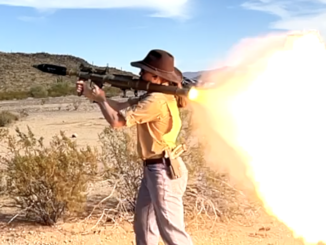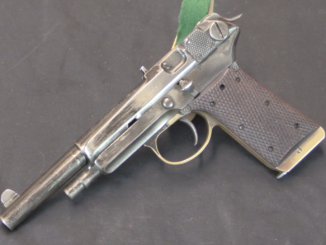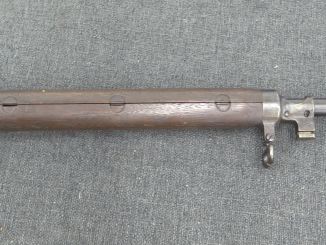The United States adopted the Vickers gun as the Model 1915, but one of its uses was as an aircraft machine gun. Since it fired from a closed bolt, the design was easily fitted with synchronizer or interruptor gear systems to fire through the arc of a propeller. The French developed an incendiary loading of 11mm Gras for use on observation balloons, and the US adopted this variation as well, ordering 1700 of them from Colt in 1918 (in addition to 4300 aircraft Vickers guns in .30-06). The guns were fitted with muzzle protectors, recoil buffers, feed block booster springs, strengthened top cover latches, ventilated barrel jackets, and a new type of fusee spring adjustment system.
This example has been fitted with a Birkigt synchronizer, as would have been used on a SPAD XIII in American service.




Contrary to popular belief, observation balloons weren’t easy to set alight with standard ball projectiles. It didn’t help attackers that balloons were given lots of protection (rings of big guns, obviously). The balloon crew could also shoot back if the basket came equipped with its own machine gun. Any fighter pilot gunning for the balloons was taking a big risk, even with a large caliber weapon installed on his plane. I could be wrong.
Problems with balloons caused first confirmed combat usage of air-to-air rockets namely Fusées Le Prieur https://en.wikipedia.org/wiki/Le_Prieur_rocket
There were also larger rockets fired from mobile launcher trucks used to protect the French rail network from Zeppelin raids;
-Capt. Ernst Lehmann, Zeppelin, NY; Longmans Green, 1937, pp. 103-104, quoted in Rockets, Missiles and Space Travel by Willy Ley (NY; Viking Press 1951), pp. 166-167.
Capt. Lehmann of course perished in the Hindenberg crash at Lakehurst, NJ on 6 May 1937.
Ley points out that the French rocket gunners were assisted by having what could only be described as fantastically vulnerable targets. Namely, hydrogen-filled, unarmored, about the size of a naval cruiser, moving at a maximum of about 80 MPH at no more than about 12,000 feet vertical range, and not able to dodge very well.
cheers
eon
The page reports that the weight of the propellant is 200g but this must be more due to the size of the rocket. Some say they weighed 6 kg but I doubt that is true.
https://www.avionslegendaires.net/wp-content/uploads/2016/03/Nieuport-Fus%C3%A9e-Le-Prieur_SDASM-1068×680.jpg
Lt. Frank Luke shot down 12-14 Ballons, He became well known, because it was easy–No, Wait, because it was hard.
When I was in middle school I got really interested in WWI aviation and pilots. My hero was Frank Luke, aka “The balloon buster”. I will have go back and look again at some of the books and articles and see if he used the 11mm machine guns. Great video, above and beyond if you will pardon the play on words.
“(…)Frank Luke(…)”
According to http://www.theaerodrome.com/aces/usa/luke1.php
The Distinguished Service Cross is presented to Frank Luke, Jr., Second Lieutenant (Air Service), U.S. Army, for extraordinary heroism in action near St. Mihiel, France, September 12 to 15, 1918. Lieutenant Luke, by skill, determination, and bravery, and in the face of heavy enemy fire, successfully destroyed eight enemy observation balloons in four days.
Goering also had something of a reputation as a balloon-buster, believe it or not. Observation balloons were prized, but very difficult, targets: Eddie Rickenbacker, in the process of describing Frank Luke as being slightly off-kilter for his habit of ballon hunting, once described them as “protected by about a million machine guns.” They also usually needed to be attacked several times before they’d ignite, since the hydrogen inside had not yet mixed with oxygen. The first pass or two let O2 in through the bullet holes, pass number 2-? tried to set the lifting gas off.
Interestingly Royal Naval Air Service was equipped with shotguns firing Chain Shot to rip holes in fabric. https://sites.google.com/site/britmilammo/air-service-wwi-non-303-inch/-707-inch-12b
Hmm… a Paradox gun firing chain-shot. Great idea for shredding planes, not great for use on people.
Goering?
It takes one to bust one.
Frank Luke, Jr., the American flyer who specialized in “Balloon-busting,” was noted as something of a cowboy: pugnacious (a former boxer), strong-willed to the point of arrogance, and brave to the point of recklessness (or vice-versa). All were proven as he was shot down and killed after igniting three balloons, making a total of 19 career victories and winning the Medal of Honor posthumously. His SPAD was also equipped with the split armament. Incidentally, there was at the time some war convention forbidding the use of incendiary ammunition against humans or human-equipped targets such as airplanes. Any Allied pilot who fell into German hands was under orders to insist he shot his incendiaries at balloons only; the Germans had threatened to shoot incendiary-ammunition possessors for war crimes.
“(…)pugnacious (a former boxer), strong-willed to the point of arrogance, and brave to the point of recklessness (or vice-versa).(…)”
That being said, for me it seems like aviation during rise-of-flight era was attractive for adventure-seeking man, with inclination to take risks. First Imperial-Russian pilot to take down enemy aircraft – P.N.Nesterov – do so by ramming it and in effect lost life.
A.A.Kosakoff only scored his first by ramming, though he managed to survive that http://www.theaerodrome.com/aces/russia/kozakov.php
French pilot Roland Garos – https://en.wikipedia.org/wiki/Roland_Garros_(aviator) – famously was the first to shoot down another aircraft by firing through the propeller arc of hi own aircraft, using deflector plates on the propeller.
Belgian pilot Willy Coppens famously “landed on” a balloon he was attempting,pting to shoot down. He had shot it free of its mooring and it rose up and lifted his plane as he crossed it. He had the presence of mind to shut off his engine until he slithered off, restarted his engine and flew away. https://en.wikipedia.org/wiki/Willy_Coppens
“(…)Coppens(…)”
Wikipedia has (possibly incomplete) list of Balloon busting aces:
https://en.wikipedia.org/wiki/Balloon_buster#Balloon_busting_aces
“(…)firing through the propeller arc of hi own aircraft, using deflector plates on the propeller.(…)”
For more about firing through propeller disc I suggest reading Synchronisation Systems available here: http://quarryhs.co.uk/miltech.htm
For balloon busters, you should check out Willy Coppens. A Belgian that not only used these 11mm incendiary guns but also even made contact with the balloons themselves with his little fighter aircraft a couple of times. I believe that he was wounded by an incendiary himself but he ended up surviving the war and was still living when I was a little kid.
As documented in the 2014 Nova (PBS TV) Zeppelin Terror Attacks episode, simple incnediary ammunition had little to no effect on the hydrogen balloons. The air to hydrogen ratio was such that they were not so easy to ignite. there were several new types of delayed ignition ammunition designed to puncture the skin of the balloon to allow the hydrogen and air to mix, and then set off the incendiary charge. I believe they settled on a 1:5 ratio of standard ball ammunition to incendiary, with the first 4 cartridges poking holes and allowing hydrogen to escape around the balloon, and the 5th initing the proper air-hydrogen mix.
The rockets Capt. Lehmann described would of course make much larger holes in the gas bags, as well as carrying their own ignition source with them in the form of their solid-fuel (probably simply black powder) rocket propulsion system.
It’s easy to see why he considered them a serious threat to an airship. He was a professional who knew his business.
cheers
eon
Always had question why they used these large diameter jackets with fins cut open, instead of smaller tube like M1919 and many other machineguns used.
Production from stock of failed contract well explains why.
Well, this could be another case of not fixing a system that is not inherently broken. If the water jacket can’t hold water, chop it open and issue it to an aircraft gun just to save on your tooling costs. Developing a new barrel shroud altogether requires investment in more production tooling, not just money for a new gun part.
Simply, the first machine guns and cannons were invented and mounted by the pilots themselves and their technicians. Obviously, this was done with tools available in the field workshop and from available (often captured) weapons. Of course, no one would make a new casing in such conditions.
And then at the factory they simply copied the existing ideas.
Captured, salvaged, or STOLEN weapons, you mean.
If I remember correctly using incendiary ammunition against an ordinary aircraft was against the Geneva Convention so you would also need .303 in case you got into a dogfight.
In the famous Biggles books eg “Biggles of 266” by Capt.W.E.Johns, the British called their incendiary rounds “Buckingham”.
“(…) “Buckingham”(…)”
See 1st drawing from top: https://sites.google.com/site/britmilammo/-303-inch/-303-inch-incendiary
The Geneva Convention is late and miscellaneous.
https://ihl-databases.icrc.org/ihl/full/declaration1868
All of these bullets quickly became ineffective as the design of the Zeppelin improved, making them much less flammable.
Therefore, both on airplanes and for anti-aircraft artillery, they began to use exploding shells.
The observation balloon had a less advanced design and caught fire more easily. But it’s smaller and harder to hit. To do this, airplanes had to descend into the area of action of ground artillery and machine guns.
A really dangerous idea.
PS I read somewhere that the first Zeppelin shot down in an air battle was destroyed by one of the first bomber.
Moreover, the airplane did not fire machine guns, because he knew about the futility of this venture. He dropped the bomb.
Given the size and speed of the target, this was not difficult.
“(…)first Zeppelin shot down in an air battle was destroyed by one of the first bomber.(…)”
When, where and by whom?
The increasing use of incendiary and explosive language
on this site has become quite disturbing. I fear that it could easily balloon into something nefarious.
Let’s not make ourselves flak-bait or clowns in some flying circus.
“Nefarious”(C)
For instance?
YouTube freaks will start putting on three commercials every five minutes? 😉
A bit nerdish, but just to expand on the Hydrogen issue. Pure Hydrogen (such as inside the balloon – or Zeppelin) doesn’t burn. But mixed liberally with ordinary air is highly inflammable. So, after disappointing early WWI experience and a look at the science, they improved the incendiary bullets (either by increasing the caliber or changing their profile – or both) to cut larger holes and let out gas for following rounds to ignite the resulting mixture (note that this the reason for the visible spreading fire, rather than a big single boom) – I can recommend looking into the evolution of these rounds. A fascinating story (or at least I found so) + if you want to (please, safely) ‘experiment’ with hydrogen filled party balloons.
Are those then closed bolt semiauto guns activated by the propeller?
No, the synchronized machineguns are firing fully automatic, when the propeller blade is out of the path of the bullets. But Maxim type machine guns fire closed bolt, yes.
http://www.aerospaceweb.org/question/weapons/q0303.shtml
https://hackaday.com/2018/04/25/firing-bullets-through-propellers/
https://www.worldwar1centennial.org/index.php/communicate/press-media/wwi-centennial-news/6549-podcast-article-interrupter-gear.html
Observation balloons were very important for artillery spotting. US practice was for the observers (there were usually 2) to have a phone circuit to the division artillery CP, the corps artillery CP and a direct line to a 155mm rifle battery in order to quickly hit targets of opportunity. Some of infantry leaving the line of departure often had geometric colored markers on their backs so the observers could tell which unit was where, especially to control creeping barrages. This helped prevent the creeping barrage from getting too far ahead of the infantry that it was covering. “History of Modern US Military Small Arms ammunition” Vol.1 has a lot of information the development and production of the 11mm cartridge in US service.
One consideration for the 11mm incendiary cartridges was that initially, they were in short supply. One of the early “balloon buster” biographies (Willy Coppens?)makes mention of it during his early attempts to down the observer balloons.
In the mid-1980s, the Cradle of Aviation Museum on Long Island, N.Y. was given one of these.And they didn’t know what to make of it. I helped identify it based on the description in one of Chinn’s machine gun books. I forwarded a link to this video recently to a curator as a follow up.